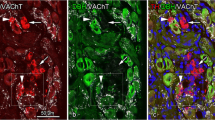Summary
The cells of the neural crest have APUD properties at an early stage of devel opment (72 hours in the chick embryo). The FIF procedure provides a cytochemical means for their distinction.
Using mouse embryos from mothers injected, intraperitoneally, 1 hr before removal, with l-DOPA (100 mg/kg), the peripheral stream of neural crest cells was clearly identifiable at the 7-somite stage (7–8 days). At the 10-somite stage (8–9 days) the cells were observed to invade the lateral processes of the foregut, and the foregut itself. A particularly high concentration of fluorescent APUD cells was observed in the anterior portion of the IVth pharyngeal pouch, destined to become the ultimobranchial body.
At the 14-somite stage (11–12 days) the developing ultimobranchial body still contains fluorescent cells of neural crest origin.
The implications of these findings on the question of the origin of the entire APUD series of endocrine polypeptide cells is discussed.
Similar content being viewed by others
References
Chibon, P.: Marquage nucléaire par la thymidine tritiée des dérivés de la crête neurale chez l'amphibien urodèle, Pleurodeles waltlii Michah. J. Embryol. exp. Morph. 18, 343–358 (1967).
Copp, D. H., Cockroft, D. W., Kueh, Y.: Ultimobranchial origin of calcitonin. Hypocalcemic effect of extracts from chicken glands. Canad. J. Physiol. Pharamacol. 45, 1095–1099 (1967).
Eränkö, O.: The practical histochemical demonstration of catecholamines by formaldehydeinduced fluorescence. J. roy. micr. Soc. 87, 259–276 (1967).
Falck, B.: Observations on the possibilities of the cellular localization of monoamines by the fluorescence method. Acta physiol. scand. 56, Suppl. 197 (1962).
Godwin, M. C.: Complex IV in dog with special emphasis on relation of the ultimobranchial body to interfollicular cells in the post-natal thyroid gland. Amer. J. Anat. 60, 299–339 (1937).
Hammond, W. S., Yntema, C. L.: Depletions of pharyngeal arch cartilages following extirpation of cranial neural crest in chick embryos. Acta anat. (Basel) 56, 21–34 (1964).
Hörstadius, S., Sellman, S.: Experimentelle Untersuchungen über die Determination des knorpeligen Kopfskelettes bei Urodelen. Nova Acta roy. Soc. Sci. upsal., Ser. IV 13, 1–170 (1946).
Johnston, M. C.: A radioautographic study of the migration and fate of cranial neural crest cells in the chick embryo. Anat. Rec. 156, 143–156 (1966).
Le Douarin, N., Le Lièvre, C.: Démonstration de l'origine neural des cellules à calcitonine du corps ultimobranchial chez l'embryon de Poulet. C. R. Acad. Sci. (Paris), Sér. D. 270, 2857–2860 (1970).
Model, P. G., Dalton, H. C.: The uptake and localization of radioactive DOPA by amphibian melanoblasts in vitro. Develop. Biol. 17, 245–271 (1968).
Nonidez, J. F.: The origin of the ‘parafollicular’ cell, a second epithelial component of the thyroid of the dog. Amer. J. Anat. 49, 479 (1932).
Pearse, A. G. E.: Common cytochemical properties of cell producing polypeptide hormones, with particular reference to calcitonin and the thryoid C cells. Vet. Rec. 79, 587–590 (1966a).
—: 5-Hydroxytryptophan uptake by dog thyroid C cells and its possible significance in polypeptide hormone production. Nature (Lond.) 211, 598 (1966b).
: Common cytochemical and ultrastructural characteristics of cells producing polypeptide hormones (The APUD Series) and their relevance to thyroid and ultimobranchial C cells and calcitonin. Proc. roy. Soc. B 170, 71–80 (1968).
—: The cytochemistry and ultrastructure of polypeptide hormone-producing cells of the APUD series and the embryologic, physiologic and pathologic implications of the concept. J. Histochem. Cytochem. 17, 303–313 (1969).
—: The characteristics of the C cell and their significance in relation to those of other endocrine polypeptide cells and to the synthesis, storage and secretion of calcitonin. Proc. IInd Int. Symp. Calcitonin, pp. 125–140. 1969. London: Heinemann 1970.
—, Carvalheira, A. F.: Cytochemical evidence for an ultimobranchial origin of rodent thyroid C cells. Nature (Lond.) 214, 929–930 (1967).
Polak, J. M., Rost, F. W. D., Pearse, A. G. E.: Fluorogenic amine tracing of neural crest derivatives forming the adrenal medulla. Gen. comp. Endocr. 16, 132–136 (1971).
Rost, F. W. D., Polak, J. M., Pearse, A. G. E.: The melanocyte: its cytochemical and immunological relationship to cells of the endocrine polypeptide (APUD) series. Virchows Arch. Abt. B. Zellpath. 4, 93–101 (1969).
Sunder-Plassmann, P.: Über neuro-hormonale Zellen des Vagussystems in der Schilddrüse. Dtsch. Z. Chir. 252, 1–18 (1939).
Wagner, G.: Die Bedeutung der Neuralleiste für die Kopfgestaltung der Amphibienlarven. Untersuchungen an Chimaeren von Triton und Bombinator. Rev. Suisse Zool. 56, 519 (1949).
Author information
Authors and Affiliations
Rights and permissions
About this article
Cite this article
Pearse, A.G.E., Polak, J.M. Cytochemical evidence for the neural crest origin of mammalian ultimobranchial C cells. Histochemie 27, 96–102 (1971). https://doi.org/10.1007/BF00284951
Received:
Issue Date:
DOI: https://doi.org/10.1007/BF00284951




